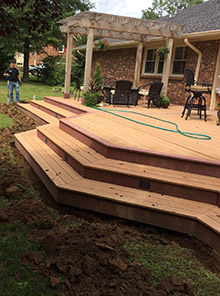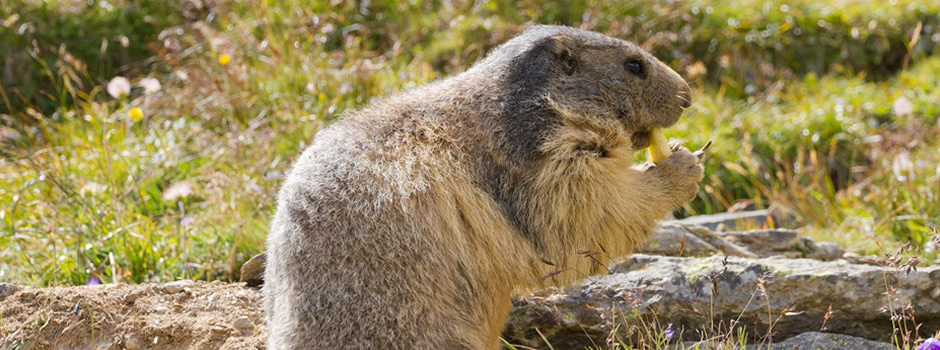Indianapolis Groundhog Removal ~ 317-559-4044
 Groundhogs can be a big problem on your property or farm as they can burrow into the ground and destroy gardens and crops, and can create a hazard for livestock and people. They can can chew their way under homes and live under foundations. If a horse or cow steps into a hole left behind by a ground hog, if can be injured and possibly break a leg. Choose Animal Pros for your Indianapolis groundhog removal problems.
Groundhogs can be a big problem on your property or farm as they can burrow into the ground and destroy gardens and crops, and can create a hazard for livestock and people. They can can chew their way under homes and live under foundations. If a horse or cow steps into a hole left behind by a ground hog, if can be injured and possibly break a leg. Choose Animal Pros for your Indianapolis groundhog removal problems.
A groundhog can cause a lot of damage to the ground structure of a yard, pasture, or garden. It’s best to deal with the situation as soon as possible. If notice burrows on your property or have seen a ground hog, contact us and we’ll take care of the problem quickly. We use humane relocation practices for ground hog control. Common nuisance complaints from Groundhogs include:
- Groundhogs digging in yard.
- Groundhogs digging under shed.
- Groundhogs digging under deck or porch.
- Groundhogs getting under home.
- Groundhogs in the crawlspace.
- Groundhogs damaging hvac duct lines.
- Groundhogs eating patio furniture.
- Groundhogs in garden.
- Groundhogs digging under concrete slab.
- Groundhogs digging under foundation.
- Groundhogs digging under barn.
- Groundhog holes create a hazard for horses.
- Groundhogs destroying vegetation in yard.
Groundhog Control And Management
 In certain situations, immediate control and management of groundhogs is crucial for severe environmental, and commercial problems. Widespread environmental and economic loss from groundhog damage is usually beyond the scope of a local trapper, or small company, and a consultation with Animal Pros specialists is needed. Large scale trapping solutions are needed to stop damage immediately. Groundhogs can wreak havoc on Commercial properties where population numbers are not properly controlled, creating large scale problems. Contact a Animal Pros specialist today for immediate assistance.
In certain situations, immediate control and management of groundhogs is crucial for severe environmental, and commercial problems. Widespread environmental and economic loss from groundhog damage is usually beyond the scope of a local trapper, or small company, and a consultation with Animal Pros specialists is needed. Large scale trapping solutions are needed to stop damage immediately. Groundhogs can wreak havoc on Commercial properties where population numbers are not properly controlled, creating large scale problems. Contact a Animal Pros specialist today for immediate assistance.
Indianapolis Groundhog Trapping
Animal Pros can help you with groundhog trapping in Indianapolis if you have groundhogs digging up your yard, digging under your shed, or getting under your home. We will set traps to catch the groundhogs that are destroying your lawn or garden, or raiding your vegetables. We will relocate the groundhogs so they don’t return and cause further damage. Groundhogs also love to eat plants, so your yard and garden are a perfect food source. Groundhogs digging in the yard can quickly destroy the plant life around your home. We will safely bait, trap and remove this pest animal.
How To Remove Groundhogs From Your Yard
Groundhogs can quickly damage your yard and even create structural problems around your home if problems persist, prompting quick removal of this large nuisance rodent. Live cage trapping is the only effective way to remove groundhogs. To prevent other groundhogs from coming into the area, follow these steps.
- Eliminate Attractants such as harvesting vegetables and crops early, and eliminating areas of cover like tree trunks, yard debris, and securing foundation openings.
- Identifiying Damage such as holes around foundation and in yard, openings under home, chewing on deck, patio, and wires, and tunnels under concrete slab.
- Do Not Seal Burrows Until The Ground Hog Is Caught. This is a natural reaction to seal burrows immediately. Ground Hogs are natures excavators, and sealing a burrow will cause the groundhog to dig out somewhere else or at the same place creating more damage.
- Proper Placement Of a Live Cage Trap. Proper placement of a live cage trap is key when trapping ground hogs effectively. A trap inproperly placed can educate a caautious ground hog to completely avoid the traps. Professional help is recommended.
- Know The Laws And Regulations. Some areas it is ok to trap a groundhog, but illegal to transport a groundhog if unlicensed through the State to do so. Know the regulations in your State, if trapping a groundhog on your own.
- Seal The Burrow or Hole. Depending on the area around the hole, will depend on how the hole is filled in. If the burrow is in your yard where grass grows, you may want to fill the hole with dirt, and then seed. If the burrow is along a foundation or walkway, you may want to use gravel, concrete, or bentonite clay.
Groundhog Biology
Groundhogs (Mermota Monax) are natures excavators, also known as whistle pig, woodchuck, and gopher. They are a large rodent that belongs to the Scuidridae family of large ground squirrels known as Marmots. Groundhogs are large and can often weigh close to 20+ pounds, although average is 8 – 12 lbs. Groundhogs are herbivorous, primarily eating wild grasses, vegetation, crops, and can be omnivorous taking advantage of small animals, insects, grubs, and grasshoppers. Groundhogs often live in the wild for a average of six years, and are one of the few animals that enters a true hibernation. Breeding and mating season occurs March – May, giving birth to on average of two to six young. Groundhogs are excellent diggers, and will use their burrows to sleep, rear young, and hibernate.
Groundhog Diseases
Groundhogs can carry rabies, and if your pet encounters a groundhog in your yard it will defend itself with its large front teeth as it stands on its back legs. Groundhogs can carry diseases much like any other animal, or harbor pathogens like fleas, ticks, and mites. Many problems associated with groundhog disease are more likely to happen when working around areas of fecal accumulation, like under the home a groundhog has been under, or around burrows.

